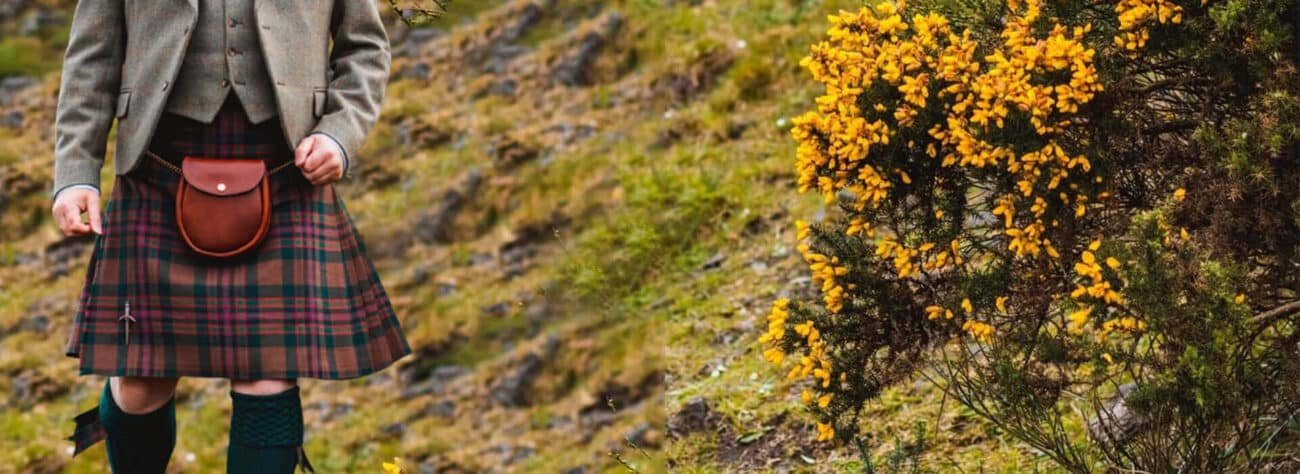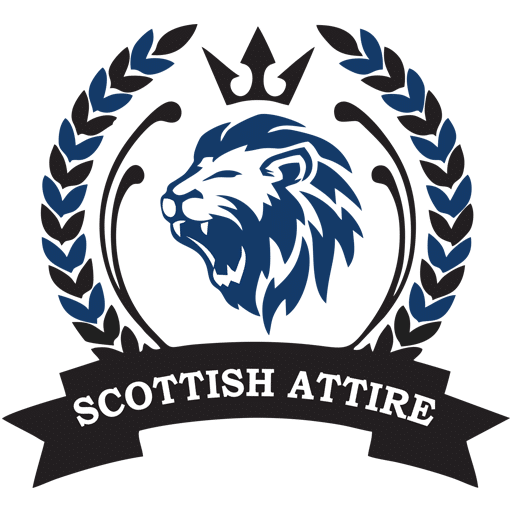The Scottish Kilt: Complete History and Buying Guide

We don’t believe anything can compare to Scottish kilts as a national costume! They’re cool, vibrant, exotic, and fashionable. Although other nations, including us Scots, can claim the kilt as a sort of national attire, traditional kilts are known as a symbol of Scotland worldwide. The kilt may have its origins in the style of clothes worn by the various invaders who first set foot on Scottish territory in the past, as it was originally a piece of clothing specifically tailored to the practical demands of Highlanders. Since then, it has undergone significant transformation and is currently primarily observed at ceremonies and official gatherings, such as weddings and military processions.
Where did the Scottish Kilt originate
Origin
The kilt you’re seeing in your head is significantly dissimilar from the original clothes Scots wore all those centuries ago. Although it is typically connected with Celtic culture, the word “kilt” may have originated from the Nordic word “kjalta,” first used in the 9th century. Early in its history, various nations conquered Scotland, including the Romans, Vikings, and Scandinavians. The original tongue of the Scandinavians was known as “Old Norse.” These invaders had distinctive clothing, including varied tunics, robes, shirts, and cloaks.
It’s still being determined exactly how the kilt came to be, but it’s thought to be a blend of all of these, modified to fit the environment and way of life of the tough, combative people who lived in the Scottish Highlands. The original Scottish kilts, called “Feileadh Mhor” (meaning “Great Kilt” and pronounced “feela mor”), which are today known as “belted plaids,” first emerged in the 16th century.

History
The Feileadh Mhor was traditionally designed from a single length of thick wool material called “breacan” (a Gaelic word that means speckled or partially colored). This material might be up to 21 feet long and was typically 5 feet broad. A strong leather belt was used to secure many feet of the fabric folded into loose pleats and looped around the wearer’s waist.
The remaining fabric was draped over the shoulder and tucked behind the back into the belt. In addition, this extra material may be pulled up over the head and shoulders to shield the wearer from cold winds, torrential rain, or snow. The entire outfit was layered over a long-sleeved tunic that came to the knees.
Over a century later, towards the middle of the 17th century, the ‘Feileadh Beag’ (also known as the ‘Philabeg’ and pronounced ‘feela beg’) started to replace this early, heavy, and somewhat unattractive version of the kilt. A single (shorter) stretch of breacan was folded loosely, wrapped around the waist, and again fastened by a thick belt to form the lower half of the Feileigh Mor.
This version, often known as the “Walking Kilt,” had no “extra” material to sling over the shoulder or employ as a cloak. Creases sewn into the fabric began to replace loose folds in the 18th century, making the entire ensemble easier to wear. Highlanders wore both kilts for a while, but eventually, the more comfortable Walking Kilt replaced the older Great Kilt as the preferred option for daily wear. Identifying it as the precursor to the modern kilt in history was much easier.

Patriotic and Historical Kilt: An Outfit
In the past, the kilt was more than just a versatile piece of clothing; it represented the Scottish Highlanders’ powerful, proud, and fiercely patriotic tradition.
The humble kilt suffered due to the English trying, mostly unsuccessfully, for decades to control the restless inhabitants of this wild area. The ‘Dress Act’ (a portion of the ‘Act of Proscription’) enacted by King George II in 1746 outlawed the kilt due to the Scottish people’s affinity to it and the fact that it was viewed as a rebellious symbol. Naturally, some Scots disregarded the prohibition and kept wearing the kilt in defiance. Given the nature of human nature, this move to outlaw wearing a kilt served to reinforce its significance to the nation-loving Scots. Instead of just the traditional Scottish garb worn by Highland clans, it became and kept on becoming a symbol of Scottish culture and national pride.
Although it was illegal for the average individual to wear a kilt between 1746 and 1782, armored regiments in the military were actively encouraged to do so. This was further scheming on the part of the English; this time, the British Government utilized the Dress Act exemption as a perk to entice the daring and combative Highlanders to enlist in the Kings’ forces.
Then, these “Highland Regiments” were dispatched into battle in countries like India and North America. The idea behind this strategy was to “take out of the equation” many Highlanders. They were rendering Scotland (and the Scottish people) more likely to be under control. Not at all. King George IV gave the Scottish kilt a fresh lease on life and a legitimacy and acceptability it had yet to experience in 1782, over 40 years later.
The King was surrounded by Scots wearing kilts in Scotland and even donned one himself. His successor, Queen Victoria, adored Scotland in general and the Highlands, which led to additional royal favor. Therefore, the English gradually changed their tune after trying to put an end to it!
What is Scottish Tartan
Today’s kilts are always constructed of tartan cloth, although this was the case in the 18th century. Each tartan is intimately associated with a specific Scottish Clan. Again, the English started assigning distinct titles and identities to various tartans, starting with the army when each Highland Regiment was given a unique tartan. What is a Scottish Tartan or Scottish Plaid, then? It is a woolen fabric that developed from the original “breacan” and has an orderly checkered pattern that typically uses multiple colors.
The ‘ sett’ of the checkered pattern is made up of colorful vertical and horizontal lines woven into the fabric to create a distinct pattern of lines and squares. Historically, any connection between a specific color or pattern and a place or district was more common than a tie to a specific family or Clan. This started to change in the 18th century when rules and regulations were put in place that allowed a Clan to claim “ownership” of a particular tartan pattern or sett. The Clan Urquhart tartan was the first to be properly registered at the beginning of the 19th century.
Although a specific Clan owns the majority of tartans, wearing a tartan kilt isn’t really governed by any laws or regulations. Scottish people may have more than one Clan tartan to choose from because it is acceptable to wear the tartan of your father, mother, or even another family member. There are many more “generic” patterns you can wear if you don’t have Scottish ancestry or are too complicated to follow. Alternatively, you can select any pattern you like. For instance, you don’t need to be legally recognized as a “Campbell” to wear a Campbell tartan. Of course, simply donning the proper kilt will not make you a clan member.
Scottish Attire Provides a wide range of Scottish Kilt
Even though the kilt is “the national costume” of Scotland, you won’t see people wearing it there or in the grocery store regularly. ‘High days and holidays’—ceremonies and special occasions—are when it is most frequently worn. Among them are festivals, family gatherings, weddings, and funerals.
Highland Dancers, Highland Bands, and competitors in the traditional Scottish Highland Games all wear it. The kilt is also a feature of several Army regiments’ “dress uniforms,” this is not just true of the British Army. In 1940 (early in World War II), when the Royal Highland Regiment engaged the German army, the last time kilts were worn in actual battle. Instead of being purchased “off the rack,” a true Scottish kilt should be custom-tailored for you. A kilt that isn’t quite the right size won’t hang correctly, ruining the “look” because of how it ties and fits.
Our kilt accessories will give you the complete “look” if you desire a truly authentic experience. These consist of the following:
The Belt
Historically, belts were made of leather and had ornamental buckles.
The Sporran
Sporran is derived from the Irish word “spleuchan,” which means “purse.” Since kilts lack pockets, men typically keep their “stuff,” including cash, keys, and other items, in sporrans. It is a tiny belt bag made of leather or an animal hide.
Kilt Knife
Also known as a “Sgian Dubh” or “black knife” in Gaelic. It’s a little knife with a leather sheath and frequently a fancy bone handle. It is kept customarily concealed inside the top of a man’s hose (socks).
Kilt Pin
A little ornamental pin is worn on the front panel of the kilt.
Hose (Socks) and Shoes
Ghillie Brogues are a type of footwear. Traditionally, tongueless, sturdy leather shoes with laces (shoe strings) were designed. They most likely developed from the footwear used by the earliest Highlanders, made of leather or skin wrapped around the feet and fastened with leather thongs. Woolen knee-high socks are known as hose. Possibly one color or a striped pattern.
If you’re interested in buying kilt or accessories, please visit our shop page to view all varieties: kilt for men, kilt for women, tartan kilt, and kilt jackets. All kilts are made of superior quality of fabric. Additionally, Scottish Attire offers custom kilt for you on demand. Please contact our WhatsApp or via live chat.

